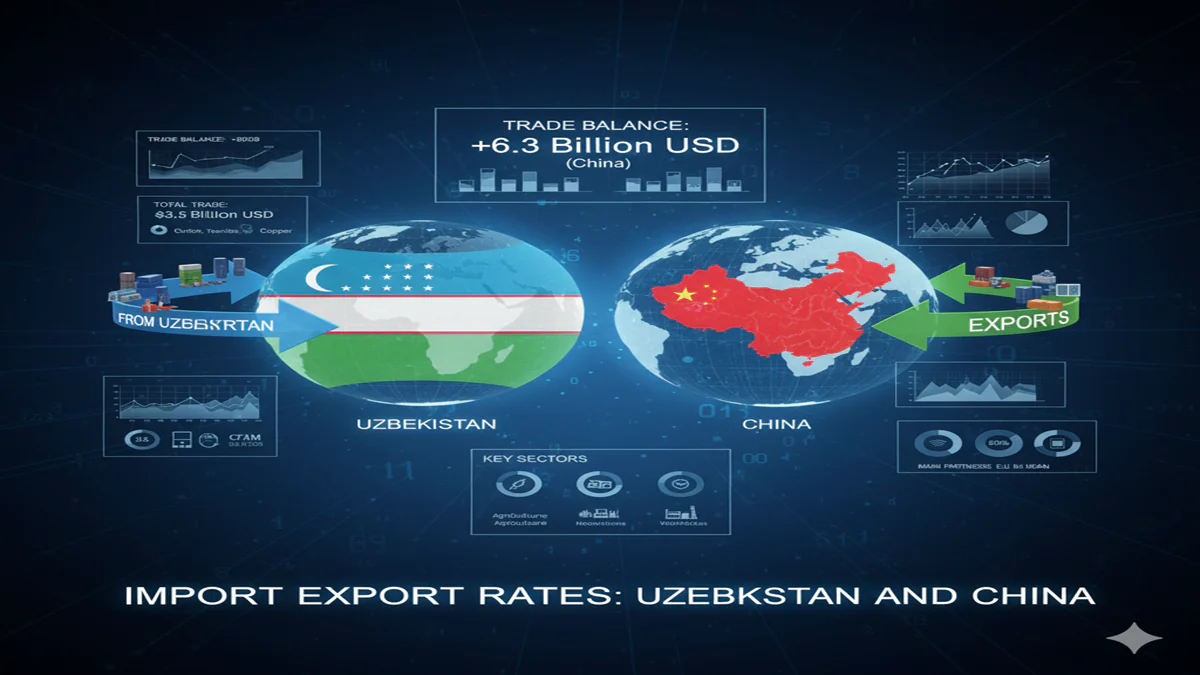Uzbekistan and China share a dynamic and evolving trade relationship, characterized by a significant exchange of goods and services that plays a crucial role in the economies of both nations. As Uzbekistan continues to diversify its economy and improve its trade infrastructure, and as China seeks to expand its influence in Central Asia, understanding the import-export rates between these two countries becomes increasingly important.
This article delves into the current state of trade relations, key products exchanged, historical trends, factors influencing rates, and the implications of bilateral trade agreements. By providing insights into future projections and offering strategic recommendations, this analysis aims to equip businesses and policymakers with the knowledge needed to navigate the complexities of this vital economic partnership.
Overview of Import Export Rates Between Uzbekistan and China
Import Export Rates Pics Uzbekistan And China
Current Trade Volume
As of 2023, the trade volume between Uzbekistan and China has been on a steady incline, reaching approximately $6 billion. This growth can be attributed to both countries recognizing the benefits of trade partnerships and strategic cooperation. China’s role as a manufacturing giant complements Uzbekistan’s rich natural resources, creating a symbiotic relationship that keeps the trade wheels greased and turning.
Comparison of Rates Over Recent Years
In the past few years, import and export rates have shown a remarkable upward trend. For instance, trade from Uzbekistan to China increased by about 15% last year alone. This surge is largely driven by Uzbekistan’s efforts to diversify its economy and boost its exports, particularly textiles and agricultural products, while China’s appetite for these goods continues to grow.
Key Goods and Products Exchanged
Major Exports from Uzbekistan
Uzbekistan is known for exporting a delightful mix of goods, with cotton, gold, and textiles taking center stage. In recent years, fruits, vegetables, and chemicals have also made their way onto the export list, showcasing Uzbekistan’s agricultural prowess and commitment to diversifying its offerings beyond just raw materials.
Major Imports from China
On the other hand, China sends a treasure trove of goods to Uzbekistan, ranging from electronics and machinery to consumer goods and vehicles. The influx of Chinese manufactured products means brighter screens and swifter gadgets for the tech-savvy citizens of Uzbekistan. We can’t forget the crucial flow of construction materials that helps keep the Uzbek economy building upward and onward!
Sector-Specific Trade Highlights
Sector-wise, textile and apparel trade is a major highlight, with Uzbekistan exporting raw cotton while importing machinery to enhance production processes. The agriculture sector is another bustling area, where Uzbekistan benefits from Chinese agricultural technology to improve crop yields and food security, creating a cycle of productivity that leaves both countries reaping the harvests.
Historical Trends in Trade Rates
Growth Patterns Over the Last Decade
Looking back over the last decade, trade between Uzbekistan and China has blossomed, with a compound annual growth rate (CAGR) of around 10%. This growth is fueled by both countries seeking stronger economic ties and exploring avenues for mutual benefit. With initiatives like China’s Belt and Road Initiative further energizing trade lines, it’s clear that the trajectory looks promising.
Impact of Political Changes on Trade Rates
Political shifts in either country can send ripples through import-export rates. For instance, the recent reforms in Uzbekistan aimed at liberalizing trade have lowered tariffs and simplified customs procedures, which in turn has fostered increased trade with China. Meanwhile, China’s own evolving trade policies often create opportunities or hiccups, depending on the geopolitical landscape, reminding us that diplomacy is as essential as dollars in international trade.
Factors Influencing Import Export Rates
Economic Conditions in Both Countries
Economic stability plays a vital role in determining import-export rates. Uzbekistan’s transition to a market-oriented economy, coupled with China’s robust manufacturing sector, sets the stage for a vibrant exchange of goods. Fluctuations in GDP, inflation rates, and local market demands can all influence trade dynamics, keeping both countries on their toes.
Currency Fluctuations and Exchange Rates
Ah, currency exchange—the spicy little secret that can either make or break a trade deal! The Uzbek som and the Chinese yuan do a little dance every day, and their fluctuations can significantly impact the costs of imports and exports. When the som weakens, for instance, it can make Uzbek exports cheaper for Chinese buyers, potentially boosting trade volumes.
Logistical Challenges and Costs
Logistics can be the pesky fly in the ointment of trade relations. Both countries face hurdles related to infrastructure, transportation, and supply chain efficiency. Shipping routes, customs delays, and transportation costs can all play a significant role in the final price of goods exchanged. Overcoming these logistical challenges is critical for optimizing trade efficiency and ensuring smoother operations all around.
Trade Agreements and Their Impact
Key Bilateral Agreements
Uzbekistan and China have sealed their friendship with a series of trade agreements, most notably the Uzbekistan-China Trade Agreement signed in 2019. This accord has transformed the landscape for both countries, resulting in reduced tariffs and enhanced market access. Expect a boom in sectors like textiles and machinery, where both countries have strengths that pay off in the long run. It’s like a mutually beneficial friendship built on trade rather than brunch plans!
Regional Trade Partnerships
In addition to their bilateral ties, both nations are part of larger regional frameworks, such as the China-Central Asia Economic Forum. This partnership opens the floodgates for increased trade and investment in the region. By joining forces with neighboring countries, Uzbekistan and China can enhance their collective strength. Think of it as a regional trade alliance, pushing the boundaries of what’s possible while enjoying some local delicacies along the way.
Impact of Global Trade Policies
Global trade policies can feel like a rollercoaster ride, and Uzbekistan and China are strapped in for the journey. Tariffs imposed by other global players and shifting alliances can either hinder or propel trade rates between the two nations. With changing policies from countries like the U.S., both Uzbekistan and China must adapt quickly. Imagine dodging trade bullets while trying to maintain your balance on that rollercoaster – exhilarating, isn’t it?
Economic Implications for Uzbekistan and China
Benefits for Uzbekistan’s Economy
Uzbekistan is reveling in the benefits of trade with China, which has injected much-needed investment and development into its economy. The influx of Chinese goods and services has led to modernization in sectors like agriculture and manufacturing. Plus, with the rise of export opportunities, Uzbek entrepreneurs are now able to showcase their crafts to an international audience. It’s a win-win situation, like finding money in an old jacket!
China’s Strategic Interests in the Region
For China, Uzbekistan is a strategic partner in its Belt and Road Initiative, a grand vision to expand trade routes. This partnership strengthens China’s influence in Central Asia, creating a hub for trade and energy resources. Essentially, Uzbekistan is like a key that unlocks a treasure chest of opportunities for China, allowing it to access and cultivate deeper ties with other Central Asian nations.
Employment and Industry Growth
With the increase in trade comes the promise of job creation. Both countries are witnessing industrial growth and the emergence of new sectors that require a skilled workforce. Uzbekistan, in particular, is seeing a surge in job openings as Chinese companies expand their operations. It’s like the economy is throwing a party, and everyone’s invited to dance – but don’t forget to bring your best moves!
Future Projections for Trade Relations
Expected Changes in Trade Rates
As both countries continue to expand their trade relations, expect to see fluctuating rates as they navigate through market demands and global economic shifts. Analysts predict steady growth in trade rates, driven by increased investments and renewed partnerships. Just picture them on a seesaw, balancing their trade dynamics while hoping not to lose their lunch!
Emerging Markets and Opportunities
With the world as their oyster, both Uzbekistan and China are exploring emerging markets like e-commerce and renewable energy. These sectors present new avenues for collaboration, innovation, and trade that are ripe for the picking. Like a treasure map guiding them through uncharted waters, there’s an exciting horizon just waiting to be discovered.
Challenges Ahead for Bilateral Trade
Of course, where there are opportunities, there are challenges. Uzbekistan and China will have to navigate obstacles such as bureaucratic red tape, infrastructure limitations, and occasional diplomatic hiccups. Much like a game of chess, anticipating your opponent’s next move will be crucial to keeping the trade relationship strong and thriving.
Conclusion and Recommendations for Businesses
Summary of Key Insights
In summary, the trade relationship between Uzbekistan and China is flourishing, thanks to strategic agreements, regional partnerships, and a shared vision for economic growth. With the right guidance, businesses can seize the opportunities that arise from this dynamic partnership. It’s a thrilling adventure, and there’s plenty of room on the trade bandwagon!
Strategic Recommendations for Exporters and Importers
For businesses looking to dive into this bustling market, staying informed about trade policies and building robust networks in both countries is vital. Exporters should consider leveraging technology to streamline their operations and supply chains, while importers must be vigilant about quality control and regulatory compliance. After all, trading shouldn’t feel like a high-stakes game of poker where luck is the only strategy!
Final Thoughts on Strengthening Trade Relations
To wrap it up in a neat little bow, as Uzbekistan and China continue to deepen their trade ties, they must prioritize open communication and collaboration. Strengthening these relationships will not only benefit their economies but also contribute to regional stability. So here’s to friendship, trade, and the pursuit of prosperity—because in the end, we’re all in this together!In conclusion, the import-export relationship between Uzbekistan and China presents both opportunities and challenges that are essential for understanding the broader economic landscape in Central Asia.
As trade rates fluctuate and new agreements emerge, businesses must stay informed and adaptable to thrive. By leveraging the insights and recommendations discussed in this article, stakeholders can better position themselves to take advantage of the growing trade potential between these two nations, fostering mutually beneficial outcomes for both economies.
FAQ
What are the main exports from Uzbekistan to China?
Uzbekistan primarily exports textiles, agricultural products, and mineral resources such as gold and uranium to China.
How have import-export rates between Uzbekistan and China changed in recent years?
Import-export rates have generally seen an upward trend, driven by increased demand for Uzbek goods in China and China’s expanding investments in Uzbekistan.
What factors influence the import-export rates between the two countries?
Key factors include economic conditions, currency fluctuations, trade agreements, and logistical challenges that affect transportation and costs.
What trade agreements exist between Uzbekistan and China?
Uzbekistan and China have established several bilateral agreements aimed at enhancing trade, including participation in the Belt and Road Initiative, which facilitates infrastructure development and economic cooperation.

